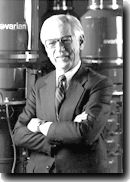Ed Ginzton held at Angel Island?
early SLAC history question by Jack Truher 2010-03-12
An interesting story on the Angel Island immigration station appeared in the San Francisco Chronicle (Jan21,2010). I suspect that one of SLAC's founders also was detained as an immigrant from Asia on Angel Island. From the article linked:
"Various ethnicities, had problems with immigration officials getting through Angel Island. Roughly 7,000 Russians passed through the station, most of them stateless political refugees who had fled Russia after the Bolshevik revolution and who had headed to the United States through Manchuria and China. They had to prove they were not criminals or likely to be deadbeats."
It's likely that Ed Ginzton was one of those "7000 Russians" who took the same long march to America. In a chance encounter, he told me personally that he was born in Ukraine, that his family became refugees from the Bolshevik revolution, and fled east, over years passing through China, arriving in California in 1929 .
Stanford Professor Edward Ginzton (1915-1998) chaired meetings for the original proposals and led establishment of SLAC in the late 1950s, along with Dr. Panofsky.
 ........... ........... 
"Ginzton brought the Monster to Stanford. From 1957 to 1961, he was the director of Project M, which later became the Stanford linear accelerator. In a recent interview with Stanford, he recalled those heady days. “There was a sense of excitement,” he said, “of promise, and of personal pride in participating in a project of great importance.” "
He was also long-time chair of Stanford's Department of Applied Physics. My wife and I sat for an hour with Dr. Ginzton at one of the SLAC staff recognition dinners at the faculty club we attended, perhaps in 1985, when I had been at SLAC for 20 years. Recently retired from his presidency of Varian Associates (1961-1984) on that night, he told us the story of his childhood exodus and early years in the US in considerable detail. He didn't say anything about being held at Angel Island.
In that era, with children of our own, my wife and I were interested in what made for "good schools". I left even more certain that the influence of schools was limited; that early family and cultural exposures, and raw talent, are more important.
Ginzton told us that when he arrived from China, he spoke no English. He found himself, at age 13 placed in an elementary school in a first grade classroom, then again in the second grade, and so on, at each stop demonstrating that he was at least at grade level among his age peers. Within a few months, he sat with his age group, and within eight years, he had an electrical engineers' degree from UC Berkeley.
As various topics emerged in conversation, Dr. Ginzton's style was to inquire first what we knew about a topic and then he embellished and augmented from his experience which was ample. Professorial in an admirable way, it was plain that he measured carefully his partners in conversation. He still had all the right stuff.
 ............. ............. 
Ginzton would be comfortable today seeing the "new SLAC" bringing new equipment and techniques into accelerator physics, for materials science, and biology. That's like what he did for Varian Associates in a variety of scientific instrumentation and equipment acquisitions.  Here is a record of an IEEE interview with Ginzton in 1985, within a few months of when I met him. It even has a little audio of the good professor. Here is a record of an IEEE interview with Ginzton in 1985, within a few months of when I met him. It even has a little audio of the good professor.
Addendum: I wrote something related for my neighbors in Cupertino. -- Jack
Close to the intersection of Highway 280 and the Foothill Expressway, there is a neighborhood Varian Park in Cupertino, next to Stevens Creek School and the Creek of the same name, and adjacent to Varian Street. How did that happen?
Russell and his wife Dorothy built the one-story house still at end of Varian Street, where they also installed an orchard quality water distribution system for a small experimental fruit orchard.
Russell Varian was a taciturn, lanky hiker, and a brilliant physicist in
electromagnetism in the late 1930-50s. He was involved early in World War 2 radar technology development at Stanford.

Russell became a founding partner of Varian Associates which made a lot of radar generation devices for the war effort. Concurrent with Hewlett-Packard, Varian Associates was the beginning of Silicon Valley tech boom. H.P. had the better business sense for growth. Russell took some of his Varian founder's millions and bought property to include the our nearby park.
I worked at Varian Associates, the scientific equipment company in Palo Alto, just long enough to get a sense of the place in the early 1960s.
Russell also bought the Cupertino creekside property because it had good access to the Skyline mountain range to the West, where he often hiked. Russell long struggled with heart problems --from which he died quite young in 1959. Russell and Dorothy Varian opened Castle Rock Park to the public with a 27 acre donation in 1948. Dorothy remained an active conservationist throughout her life, organizing expansion of Castle Rock park to some 2200 acres. This very pleasant lady remained in their home they built until her death in July of 1992.
Dorothy wrote a book, published in 1968, "Russell and Sigurd Varian, the
Inventor and the Pilot." Russell was the inventor; Sigurd, his brother, was
the pilot and business man.

-- Jack Truher
retired, at SLAC 1965-1996.
|